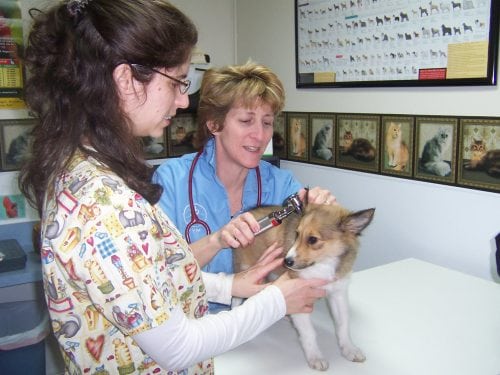What happens during your pet’s annual exam?

Every year a pet is required and recommended to have a physical examination by a veterinarian. This is mostly directed towards domestic animals like cats and dogs but often the same principles apply to equine or swine, just in a different capacity.
Ensuring your pet has an annual exam on a yearly basis will not only help keep them healthy but help in early disease prevention. Each pet has different needs and physical conditions; therefore keeping touch with the changes they endure over the years is essential. Many areas of the body are checked during a physical examination.
The exam begins with a doctor’s assistant or technician helping get the patient’s weight and taking a general history of how the pet has been doing over the recent months. They note any changes in diet or eating habits, water consumption, weight gain or loss, changes in bowel movements or urination and determine if there is a need for refills on heartworm preventative, flea prevention or other medication refills that may be needed due ongoing health conditions. They will also assess the need for any necessary vaccinations or other procedures like nail trims, anal gland expression or dental care concerns at that time.
Once the doctor arrives the physical examination will take place. The veterinarian checks the eyes, looking for clarity, scratches, irritation and tear production. Then the ears for skin hardening/softening or discharge ensuring there are no wounds, swelling or abnormalities. When looking at the eyes and ears any odor’s or levels of discomfort are also noted.
The skin and coat are evaluated for any lumps, bumps, scabs, rashes, texture and the skin turgor test is often done. This is when the skin is slightly pinched to determine how well it responds and returns to normal determining whether or not the animal may be dehydrated.
 The neck, chest and breath sounds are checked for any difficulty in breathing, the heartbeat is assessed for any irregularities. Any abnormal noises such as wheezing, coughing, or trouble inhaling or exhaling is found at this point in the examination. The ability for the patient to move his or her chest wall while breathing is a very important part of the exam.
The neck, chest and breath sounds are checked for any difficulty in breathing, the heartbeat is assessed for any irregularities. Any abnormal noises such as wheezing, coughing, or trouble inhaling or exhaling is found at this point in the examination. The ability for the patient to move his or her chest wall while breathing is a very important part of the exam.
The mouth and teeth are checked for tartar build up, decay, gum color, quality of the teeth and overall oral health. If the client is doing home dental care as directed by the staff and veterinarian it can make for positive feedback and results during the dental portion of the exam.
The doctor will then review their evaluation of the pet’s exam with the client, taking time to discuss any concerns, give encouragement, or recommend further procedures. At this time depending on the age of the pet wellness blood work may be discussed. This is often helpful for cats and dogs as they age and reach what is known as the senior years to help develop baselines in the blood levels in case an illness occurs later down the road.
An annual exam is also a good time for clients to discuss any other questions or concerns they may have about their pet. Early disease protection and prevention are key’s to keeping your pet healthy. Ensuring they have an annual physical every year can only be a benefit.



